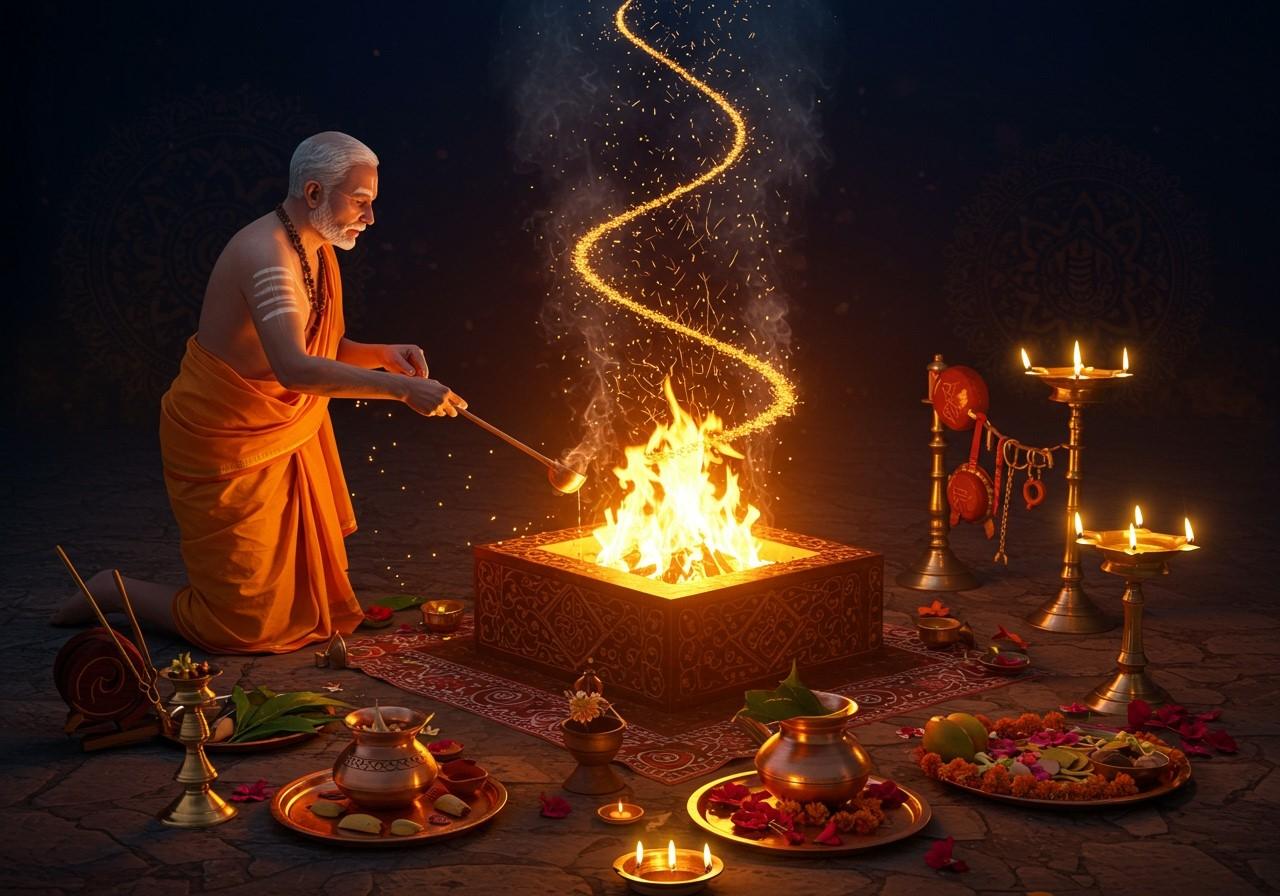
This blog delves into the ancient and sacred Yajna ritual, a cornerstone of Vedic traditions. Also known as the Vedic fire ceremony or Homa, this practice involves offering items into a fire while chanting Vedic mantras. We’ll explore the historical roots and profound significance of Yajna in Hindu culture and its continued relevance in contemporary Indian homes.
Significance of Yajna
Yajna holds deep spiritual and communal importance. It is believed to purify both the surroundings and the participants’ minds. Agni (Fire) serves as a divine messenger, carrying offerings to the gods. Yajna promotes harmony and balance within the cosmos, upholding the natural order (Rta). It acts as a medium to express gratitude towards deities and nature. Performing Yajna is believed to bring prosperity, health, and spiritual growth.
Types of Yajnas
Vedic traditions encompass various types of Yajnas:
- Agnihotra: A simple daily ritual performed at sunrise and sunset, symbolizing the cyclical nature of life and the eternal flame of devotion.
- Darshapurnamasa Yajna: Conducted on new moon and full moon days, this ceremony aligns with lunar cycles and celebrates the celestial rhythm of the universe.
- Soma Yajna: A complex ritual involving the offering of the Soma plant, a sacred intoxicant believed to bestow divine blessings and spiritual insights.
- Ashvamedha Yajna: A grand horse sacrifice performed by ancient kings to demonstrate power and sovereignty, now largely symbolic and rarely practiced.
- Putrakameshti Yajna: Performed to invoke divine blessings for progeny, this ceremony reflects the importance of lineage and continuity in Vedic culture.
- Vajapeya Yajna: A ritual signifying victory and power, often performed by rulers to celebrate triumphs and maintain authority.
- Rajasuya Yajna: An elaborate ritual denoting the sovereignty of a king, involving intricate ceremonies and offerings to reaffirm royal status.
Ritualistic Procedures
Performing a Yajna involves several key steps:
- Selecting an auspicious time (Muhurta): Consulting astrological charts to determine the most favorable time for the ritual.
- Constructing the Yajna kunda (fire altar): Precisely building the altar according to Vedic specifications, creating a sacred space for the ceremony.
- Using specific materials: Gathering materials like ghee, wood, and herbs, each with symbolic meaning and purpose in the ritual.
- Role of the Yajna Acharya: The officiating priest (Yajna Acharya) and assistants play key roles in guiding the ceremony and chanting mantras.
- Chanting Vedic mantras: Reciting specific mantras with deep spiritual meaning, invoking divine energies and blessings.
- Making offerings (Ahutis): Symbolically offering items into the fire, representing the surrender of ego and the offering of gratitude.
- Concluding with blessings: Distributing Prasadam (consecrated food) and offering blessings to participants, sharing the sacred energy of the ritual.
Preparation for Yajna
Essential preparatory steps before conducting a Yajna include:
- Ensuring purity: Maintaining physical and mental purity for participants through cleansing rituals and mindful practices.
- Purifying the space: Cleaning and purifying the Yajna space and utensils, creating a sacred and respectful environment.
- Traditional attire: Wearing traditional attire like dhoti and sari, symbolizing reverence and connection to tradition.
- Gathering ritual items: Collecting specific items like ghee, samidhas (wood sticks), and havan samagri (mixture of herbs and grains).
- Observing preparatory vows: Participants may undertake fasting and other vows to enhance spiritual focus and devotion.
- Inviting qualified priests: Engaging learned priests to officiate the ceremony, ensuring proper adherence to Vedic rituals.
- Community participation: Organizing a Yajna is a collective effort, fostering community bonds and shared spiritual experience.
Modern Relevance of Yajna
The Yajna ritual remains prevalent in modern Hindu homes and temples, adapting to contemporary times. Yajna fosters a sense of community and cultural continuity. It is performed for personal milestones like weddings, birthdays, and housewarmings. Eco-friendly Havan rituals are conducted for air purification. Online services for organizing Yajna enhance accessibility for urban dwellers. Scientific studies are exploring the environmental and psychological benefits of Yajna.
How Poojn.in Can Assist You with Yajna Rituals
Poojn.in provides all the essential items you need to perform Yajna rituals authentically and conveniently:
- Yajna Samagri Sets: Comprehensive packages containing all necessary items for the fire ceremony, curated by Vedic experts.
- Pure Copper Havan Kund: Traditional fire vessels in various sizes, meeting Vedic specifications for optimal ritual performance.
- Premium Quality Havan Samagri: Pure herb and wood mixtures for sacred offerings, ensuring the highest quality and purity.
- Additional items: Explore our range of Cotton Wicks, Ghee for Yajna, Wooden Spoons, Kusha Grass, and other Yajna Accessories.
Poojn.in offers detailed usage instructions, secure online ordering, and reliable delivery across India. Products are carefully packaged to preserve their purity and sanctity.
Visit www.poojn.in or consult our experts for guidance on selecting the right Yajna items for your specific needs.
Conclusion
The Yajna ritual, deeply rooted in Vedic traditions, holds a significant place in our cultural and spiritual lives. By understanding the preparatory steps and its modern relevance, we can preserve the essence of this sacred ceremony. Yajna connects us to our heritage and unites the community, fostering harmony and well-being. Whether performed traditionally or adapted to modern lifestyles, Yajna remains a meaningful and enriching practice.
Embrace the Yajna ritual with reverence and experience the peace and positivity it brings into your life. For more insights into related practices, explore our articles on the science behind Puja, aligning Puja with celestial energies, Navagraha Puja, and the power of the Gayatri Mantra.


